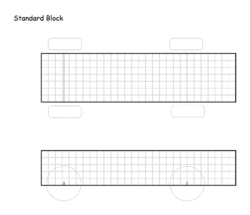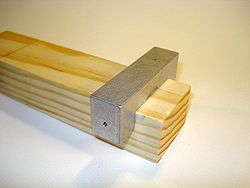How To Build a Pinewood Derby Car/Block
This chapter covers designing the car, setting the wheelbase and drilling the axle holes, cutting out the block, adding weight holes, sanding, and painting. At the end of this process, you will have a car body that weighs approximately 4.25 ounces that is painted and is ready for the insertion of wheels and axles. If you are not absolutely sure about what is allowed in your pack, district, or other organization's rules, now is the time to find out. Remember, there is no single set of rules and there is wide variation among the different sets. Get a hard copy of your organization's latest rules and if you have any questions, ask. Of particular importance in this chapter is whether the stock wheelbase and axle slots must be used. Another issue is the weight of the wheels. If your organization allows light wheels, you will need up to one-third of an ounce of additional weight in the body to make up for the reduced wheel weight.
Designing the car
[edit | edit source]

The standard pinewood derby block is approximately 7.0 inches long by 1.75 inches wide by 1.25 inches tall. It has a typical density of 0.0138 lbs/in3.[1] The block is supplied unsanded with grooves cut on the bottom side to accept the axles. The blocks weigh approximately 3.4 ounces.
The first step in designing your car is picking the wheelbase. If the rules of your race do not specify that the original wheelbase or axle slots must be used, it is often possible to improve car performance using the longest wheelbase. WIth a long wheelbase, the weight can be moved further to the back while still remaining forward of the rear axle and errors in wheel alignment will affect the long wheelbase car less since it has a larger turning radius for a given angular wheel deflection. The standard pinewood derby wheelbase is about 4.5 inches. The extended wheelbase is 5.75 inches with the wheels 5/8 inch from the end of the 7 inch block.[2] Even when the standard wheelbase is required by the rules, it may be possible to move the rear axle back by cutting off the back of the block, leaving 5/8 inch between the axle slot and the back of the block, and gluing the removed piece to the front of the car.
A design template may be useful for designing your car. There are templates available online (both free[3][4] and commercial[5][6][7]) Keep in mind where the weights will go and how much space you will need. Remember that you want the center of gravity to the rear and low.
Drilling the Axle Slots
[edit | edit source]

Axles can be installed in slots or holes. Unless installation in the original slot is required, a drilled axle hole will make wheel and axle alignment easier. If the axle slots must be used, you should still drill a pilot hole in the slot to assure that it is the correct size. The holes should be drilled with a #44 bit (0.086 inch decimal equivalent) for a 0.087 inch axle. A #43 (0.089 inch decimal equivalent) can be used for oversize axles or pre-1999 car kits.[8] The bit should be held in a drill press or, if one is not available, an axle hole jig can be used.
The performance of the car can often be improved if one wheel (typically front) is raised approximately 1/32 to 1/16 inch on the car body. This wheel is not in contact with the track and doesn't spin, thus (ideally) the rotational energy is lower and translational kinetic energy (and speed) is higher (see the chapter on Physics for more information). Note that the wheel-to-axle friction is not reduced since the car's weight is distributed on three rather than four axles. The raised wheel may still contact the guide rail and, if it contacts the track, energy is expended when the wheel spins up to speed. The smoother the track, the greater the three-wheel advantage.
Cutting out the block
[edit | edit source]

After you have settled on a design, drilled the axle holes and decided where the weights will go, it is time to cut out the block. Use a pencil to mark the cuts and use a coping saw, scroll saw or band saw to cut the block. The venerable wedge or "flying doorstop" design can be created with a single cut of a miter saw. After cutting, a wood file or rasp or a hand held rotary tool, such as the Dremel Moto-tool can be used to round edges and add detail. A small amount of wood whittling can be used to good effect.
Once the overall shape of the block has been achieved, use sand paper to create a smooth surface. Start with coarse (50 to 60 grit), and move on to finer grit (150 to 220).
It is often easier to cut the weight holes (see below) before cutting out the body.
Adding weight
[edit | edit source]
Before painting the block, you will want to add enough weight to bring the block, wheels, axles, and any accessories to about 4.9 ounces. Do not go over this weight; it is easier to add weight than to take it away, especially if you plan ahead.
The best car designs typically have the center of gravity (balance point) such that most of the weight is over the rear wheels. A center of mass 1 to 1.25 inches in front of the rear axle is readily achieved and gives good performance.[9] A rear bias places more of the downward force on the rear wheels and less on the front wheels (one of which may be raised anyway[10]) Another positive effect of rear weight bias is the slightly greater potential energy that results from the car center of mass starting at a greater height above the flat portion of the track. However, if the weight is too far to the rear, the nose of the car may lift and the car may jump the track. This is a greater problem on older wood tracks. On S-shaped tracks with a gently sloping start, a front bias can be helpful for quick acceleration.[11]
Several materials and a number of different kinds of weights can be used and each requires planning for proper placement.
- Lead
- Lead is the one of the most often used weighting materials for pinewood derby cars. Lead can be easily cut to achieve the desired weight. Drawbacks are its toxicity, especially the fumes when heated. Melting and pouring lead is not recommended due to dust and fume inhalation and the possibility of splashing onto the eyes and skin.[12] A 3/8" diameter lead wire weighs one ounce for every 1-1/2".

- Tungsten
- Tungsten is about 70% more dense than lead (19.25 g/cm3compared to 11.34 g/cm3) and therefore gives you the same weight in about 40% less volume. Another benefit is that, unlike lead, tungsten is not toxic. On the other hand, tungsten is hard and difficult to machine, so addition and subtraction of weight must be done by adding and subtracting tungsten ball bearings or powder. Two half-ounce 3/8" diameter tungsten cylinders is just over 3/4" end-to-end.
- Zinc
- Zinc is less dense than either lead or tungsten (7.14 g/cm3), but it is not toxic and can be cast into parts that can be attached to the car with screws or nails.[13]
The standard wheel and axle set weight about 0.48 ounces, therefore a good target weight for the block prior to wheel and axle insertion is 4.42 ounces. Put the block, wheels,and axles on the scale and add weights until the total is about 4.9 ounces. This leaves a tenth of an ounce to add prior to weigh-in; remember that it is almost always easier to add weight than to subtract it. At this point, make sure that you have a plan for bringing the car up to weight after painting and installing the wheels and that you can easily adjust the weight during the weigh-in process. Adhesive weights can be used, but it is critical that the correct guide rail clearance is maintained under the car. If you do not want to add weight to the top of the car, you should have a recessed area for weights underneath.
Weight holes can be cut using a brad point drill bit either from the rear or across the car body. Use a drill press or use care with a hand drill. The brad point drill bit (also called the lip and spur or dowelling bit) is a variation of the twist drill which is optimized for drilling in wood. Conventional twist drill bits do tend to wander when presented to a flat workpiece.
Center the weights in the body and glue them in place. Add body filler or wood putty and sand smooth. The center of mass of the body can be determined by placing the body on top of a drill bit and moving it back and forth in seesaw fashion until the balance point is reached.
Painting
[edit | edit source]

Once the block is at the proper weight with axle holes or axle slot pilot holes drilled, it can be painted. Use a good wood primer and sand between coats with 400 and 600 grit wet or dry sandpaper that has been dipped in water. When the primer has been applied, a spray paint for plastic model or general applications can be used.
Windows can be added using silver enamel with black frames, headlights in yellow and tail lights in red. Decals or stickers can be used for additional decoration.
Be creative, have fun, but give the block a few days to a week to dry before assembly.
Waxing your paint will make for less wheel braking friction also before assembly. A small amount of graphite spray paint can be applied to the point where the hub contacts the car body.
References
[edit | edit source]- ↑ BSA Standard Block - Dimensions and Mass Properties
- ↑ Precision Drilled Block
- ↑ Free Pinewood Derby Plans
- ↑ Car Outline Cutting Guides
- ↑ Pinewood Derby Car Design Help
- ↑ Winning Pine Derby Car Plans
- ↑ Pinewood Derby Car Designs
- ↑ New pinewood derby kits in 1999/2000
- ↑ Ol' Buffalo Pine Car Page
- ↑ Learn to Build A Winner by Stan Pope: How To Improve A Pinewood Derby Racing Car
- ↑ Learn to Build A Winner by Stan Pope: Science 101
- ↑ The Airborne Lead Hazard
- ↑ Pinewood Derby Car Weights